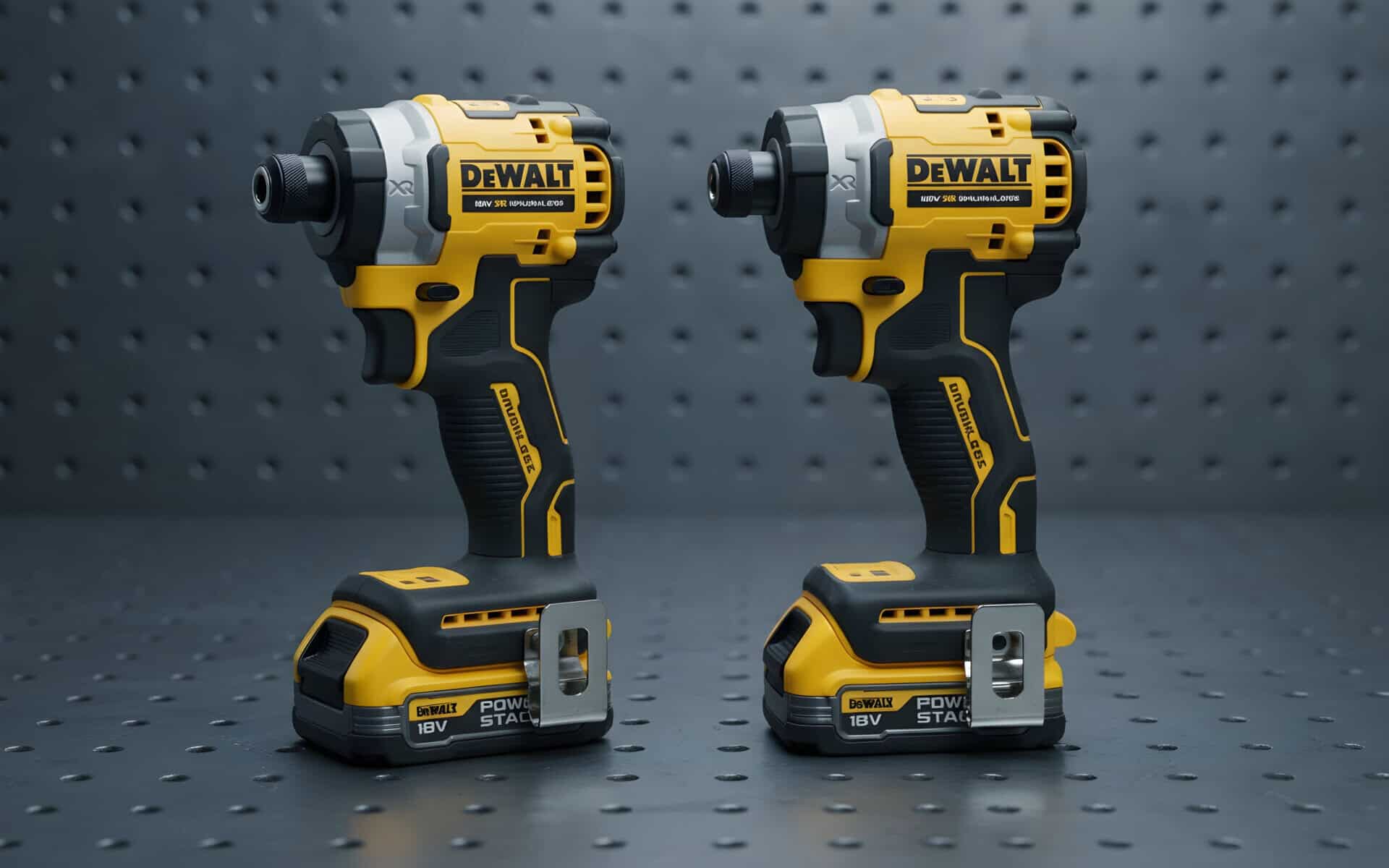Walk into some builder’s merchants, scroll through an online marketplace, or check a Facebook trade group, and you will see “bargains” that look too good to be true. A brand-new DeWalt drill at half the usual price. A Makita battery pack for £20. A Hilti saw still boxed but being flogged from a car boot.
Here is the truth: the counterfeit tool trade is massive, global, and dangerous. Estimates suggest fake goods make up 2.5 per cent of world trade, worth nearly half a trillion dollars. Electrical and electronic items, including power tools, are at the top of the list. In the UK alone, authorities seized nearly one million counterfeit electrical items in 2023, valued at almost £200 million.
For trades, the risks are real. Fake tools are more likely to fail, injure, or even kill. They void insurance, hammer your reputation, and line the pockets of organised crime. This article lays out the dangers, the warning signs, and the practical checks you can use to keep counterfeit power tools out of your kit.
The scale of the problem
Counterfeit power tools are not a niche issue. They are everywhere. Global customs data shows that electrical goods make up 45 per cent of all counterfeit seizures. Major brands targeted include Bosch, Makita, DeWalt, Milwaukee, and Hilti.
The growth of online marketplaces has made things worse. Platforms like AliExpress, Temu, and even TikTok Shop are riddled with fake listings. Sellers use stolen logos, stock photos, and dodgy certificates to look convincing. With shipping direct from overseas factories, small parcels often slip through customs unnoticed.
It is not a victimless crime. In the UK, counterfeiting drains £9 billion a year from the economy and costs around 80,000 jobs. Safety groups estimate that 98 per cent of fake electrical items fail safety tests. Globally, counterfeit electrical products are linked to 70 deaths and 350,000 serious injuries every year.
Why counterfeit tools are dangerous
Counterfeit tools are designed to look genuine but not to perform safely. Here are the most common problems:
- Shoddy materials – Bearings, gears, and housings are often made from low-grade metal that cracks under load. Blades or drill bits can shatter in use.
- Fake batteries – Lithium-ion packs without proper protection circuits can overheat, swell, or explode. Many are not even compatible with the tool’s electronics.
- Dodgy electrics – Thin cables, poor insulation, and missing thermal cut-offs make shocks and fires far more likely.
- False markings – Many fakes carry counterfeit CE or UL marks, giving the illusion of safety testing when none has taken place.
- No support – No warranty, no spares, no backup if something goes wrong. If it fails, you carry the cost.
A counterfeit might look convincing out of the box, but under stress it is a liability.
How to spot a fake
Knowing what to look for is the best defence. Here are ten warning signs that a power tool may be counterfeit.
1. The price is too good to be true
If a brand-new drill, saw, or grinder is 50–80 per cent cheaper than normal retail, be suspicious. Genuine tools rarely have huge discounts outside authorised clearance sales.
2. The seller is not reputable
Counterfeit tools often come from random websites, pop-up market stalls, or social media sellers. If the seller cannot provide a VAT receipt, warranty, or contact details, walk away.
3. Poor packaging
Check the box. Fakes often have spelling mistakes, low-quality printing, or mismatched colours. Genuine manufacturers invest heavily in packaging design and print quality.
4. Missing safety marks
Look for CE, UKCA, or UL marks. Counterfeits may miss them completely, or use marks that look slightly “off.” Compare to a tool you know is real.
5. Serial numbers that do not check out
Most brands now use serial numbers that can be verified on their websites. If the seller refuses to provide a number, or if it fails the check, it is likely fake.
6. Weight and feel
Counterfeit batteries in particular are often much lighter than genuine ones because they use cheap cells. A tool that feels flimsy or off balance is a red flag.
7. No warranty or registration option
If a tool cannot be registered for warranty through the official brand website, it is not genuine. Many manufacturers also provide free extended warranties if you register – something counterfeit sellers cannot offer.
8. Performance failures
Counterfeits often struggle under load. A drill that overheats, a battery that drains quickly, or a charger that buzzes or smells of burning are warning signs.
9. Dodgy online listings
Beware of stock photos, vague descriptions, and brand names spelt slightly wrong (Maklta, Dewelt, etc.). Counterfeiters use tricks like this to slip past filters.
10. Source of sale
Only buy from authorised dealers, major merchants, or directly from the manufacturer. That “new in box” tool at the boot sale or in a Facebook Marketplace ad is almost certainly fake.
Real-world checks
If you suspect a tool might be fake, here are some quick tests tradespeople use:
- Weigh the battery – genuine packs usually weigh more due to quality cells and electronics.
- Inspect the moulding – look for crisp edges, consistent colours, and brand engravings. Counterfeits often have rough finishes.
- Voltage test – under load, counterfeit batteries often drop below their rated output.
- Heat check – plug it in and monitor. If it gets unusually hot or smells of burning, stop using it immediately.
The business impact of counterfeit tools
It is not just individual tradespeople who suffer. Counterfeit tools hit the entire trade ecosystem.
- Merchants: selling a fake by mistake can damage reputation and lead to costly returns.
- Insurers: counterfeit failures drive up claims, from fires to injuries.
- Brands: reputation takes a hit when customers blame the manufacturer for a fake’s failure.
- Workers: injuries or delays from fake tools can put jobs, income, and safety at risk.
Every counterfeit tool bought undermines honest traders and strengthens the counterfeit supply chain.
Industry and enforcement response
Authorities are cracking down. UK Border Force seized almost one million counterfeit electricals in a single operation in 2023. Trading Standards now lists electrical goods as one of the most investigated counterfeit categories.
Manufacturers are fighting back with tamper-proof packaging, unique barcodes, and serial registration schemes. Some even encourage users to upload tool details online to confirm authenticity.
Trade groups are pushing awareness campaigns. The Power Tool Institute, Electrical Safety First, and the Anti-Counterfeiting Group all urge tradespeople to buy only from trusted sources.
But enforcement alone will not solve it. Awareness is the first line of defence.
Protecting yourself and your crew
Here are five steps every tradesperson should take:
- Always buy from trusted sources – official retailers, merchants, or manufacturer websites.
- Register your tools – log serial numbers with the brand for warranty and authenticity checks.
- Educate your crew – make counterfeit spotting part of toolbox talks.
- Report suspicious sellers – to Trading Standards or the manufacturer.
- Do not cut corners – saving a few quid upfront can cost dearly in safety and reputation.
Final word
Counterfeit power tools are not just a cheap knock-off. They are a global criminal trade that threatens livelihoods, safety, and trust in the construction industry. The lure of a bargain is strong, but the risks are far greater.
Spotting fakes is about vigilance. Look at the price, the seller, the packaging, the weight, and the warranty. Use common sense: if it looks too good to be true, it probably is.
Tradespeople deserve tools that work as hard as they do. Counterfeits will not only let you down, they can put you and your crew in harm’s way. Stay sharp, buy smart, and keep counterfeit kit out of your bag.

